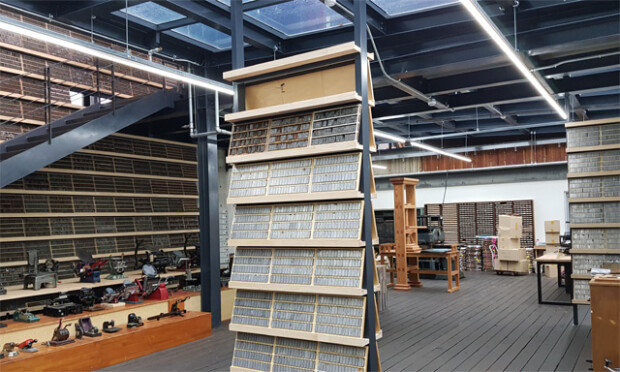Movable type exhibition attracts visitors of all ages
Movable type exhibition attracts visitors of all ages
Posted October. 05, 2019 07:23,
Updated October. 05, 2019 07:23

The “Movable Type Forest” at the Book City Letterpress Museum in Paju was bustling with visitors on Thursday. Many of them were families, watching and touching the typewriters and printing machines on display and talking about them. As many as 2,500 visitors visited the place last month. The number of visitors has soared in the second half of the year from a monthly average of 1,300 during the picnic season and summer vacations in the first half of the year.
The museum is displaying 3,500 movable types, type models, and type-casters, which were once owned by “Je-il Movable Type,” the last movable printing manufacturing factory in Korea. Also on display are printing machines and cutting machines from the Bongjin printing house in Daegu as well as folding machines and wireless binding machines from the Chungmuro printing alley in central Seoul. The museum provides a hands-on experience that is very popular to both adults and kids, where visitors can create their own book from type-picking to binding.
As is the case with the Book City Letterpress Museum, exhibitions displaying letters are evolving. In fact, letters are considered records rather than attractions, thereby having been used as evidence for books or pamphlets. But recently exhibitions and museums that allow visitors to enjoy letters in various formats are increasing in number.
This year, the National Hangeul Museum has seen the average number of monthly visitors increase by over 5,000 from a year earlier. The museum is currently holding special exhibitions called “Transformations: Experiments in Hangeul Design” and “Heroes of Hangeul.”
For the exhibition of "Transformations: Experiments in Hangeul Design," artists are presenting various art pieces under the theme “The Shape of Hangeul.” Kang Ju-hyun used different shapes and colors to visualize Hangeul’s “gather-write method,” Yoo Hye-mi carved the consonants and vowels of Hangeul on the floor so that visitors can experience the piece while walking on it, and Park Gil-jong made furniture, such as chairs, tables, and hangers, using the shapes of 28 letters of the Hangeul.
Jee-Young Kim kimjy@donga.com







